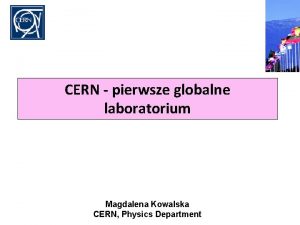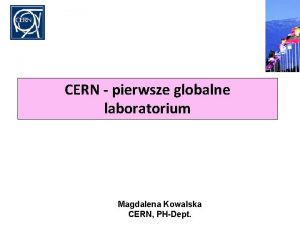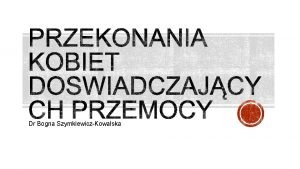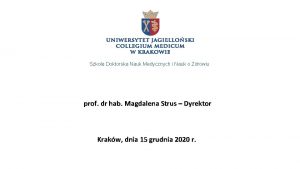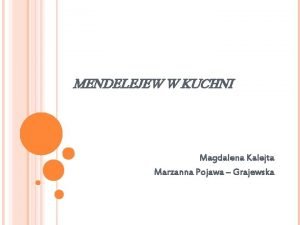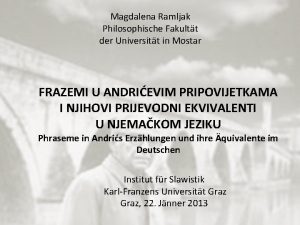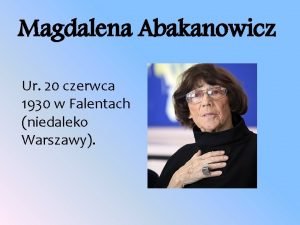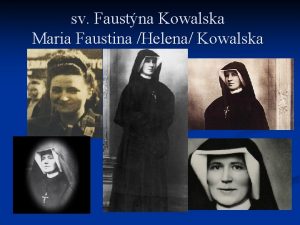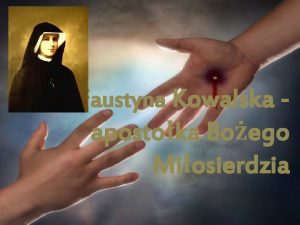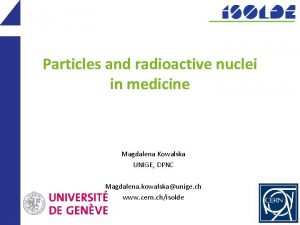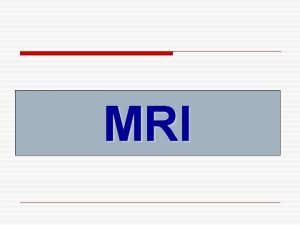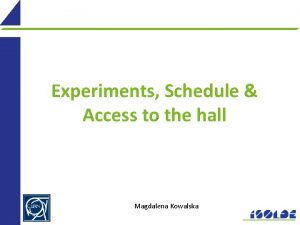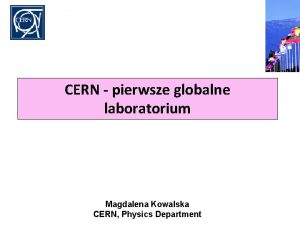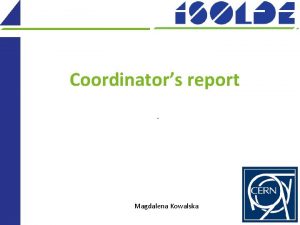Update on MRI and medical applications Magdalena Kowalska


















- Slides: 18

Update on MRI and medical applications Magdalena Kowalska, also on behalf of R. Jolivet UNIGE, CERN

Outline Our medical project at/and CERN Decay of spin-polarized nuclei Limitations of NMR and MRI Towards gamma-detected MRI in medicine Summary and outlook 2

Background

Our medical project at/and CERN Some background: My ERC grant at ISOLDE on beta-detected NMR in biology Renaud Jolivet’s medical-physics joint CERN/UNIGE appointment Ø link to Idea. Square, MAPF, Marzio, ATTRACT Article in 2016 in Nature on gamma-detected MRI Very motivated Ph. D candidate willing to work with us on gamma-MRI 4

Our medical project at/and CERN Resulting in: Active collaboration with Haute Ecole de Santé in Geneva Discussions at CERN with Thierry Stora, Etiennette Auffray and Paul Lecoq Approved CERN Medical Applications Funding – student and equipment The student: Swiss funding with Renaud and top-up from CERN Application to ATTRACT Application to FET_OPEN First contacts with industry More ideas for applications 5

Project

Decay of spin-polarized nuclei Beta and gamma decay of spin-polarized nuclei anisotropic in space Beta decay, I>0 Gamma decay, I>1/2 B 0 Degree of asymmetry: depends on degree and order of spin polarization and transition details (initial spin, change of spin) Observed decay asymmetry can be used to: Ø Probe underlying decay mechanism -> fundamental physics Ø Determine properties of involved nuclear states -> nuclear physics 7 Ø Derive differences in nuclear energy levels -> this talk

NMR principles Participants: Ø Probe nuclei with spin different from 0 Ø Sample/ environment Magnetic field Ø Strong static field (B 0) -> when different at different positions –> MRI (Magnetic Resonance Imaging) Ø Weaker field (B 1) oscillating at radio-frequency (MHz) B Radiofrequency: Change in orientation

NMR limitation: sensitivity NMR is powerful but not sensitive Ø Small degree of polarization Ø Inefficient detection Our combined paths to increase sensitivity: beta-NMR and gamma-NMR/MRI Ø Hyperpolarization Ø Detection of asymmetry in beta or gamma decay 9

MRI with hyperpolarized stable nuclei Best example: 129 Xe: Ø Polarized via spin-exchange with laser-polarized Rb Ø Applications: lung and brain MRI, encapsulation and use in body liquids 1 st medical applications of 3 He: W. Heil et al, Mainz, Nature 1996 10

New modality: gamma-MRI PET/SPECT and MRI have complementary features: Detection efficiency Spatial resolution PET and SPECT high Low (e. g. >5 mm for 82 Rb) MRI low High Solution: gamma-MRI (or simultaneous SPECT-MRI): What - Record MRI signals from PET/SPECT-type nuclei How - Hyperpolarize spins and observe asymmetry of gamma decay Result - high efficiency (gamma detection) and high resolution (MRI) Status: method shown to work: Y. Zheng, et al. , Nature 537, 652 (2016) Gamma-MRI Equipment: Ø I>1/2 gamma-emitting nuclei Ø Spin-polarizer Ø MRI magnet Ø Gamma detectors inside B field: Si. PMs 11

Gamma MRI – spatial resolution Voxel size Ø defined by slope of B-field gradients and spectral width of rf pulse Ø more nuclei -> smaller pixels possible up to B gradient and rf limit 1 pixel in resonance: Ø change in total gamma counts visible in each detector Ø Degree of change proportional to number of nuclei in addressed pixel Long Det Trans Det 2 Trans Det 1 Rotate 1 pixel by 90° 12

First gamma-MRI Y. Zheng, G. W. Miller, W. A. Tobias, G. D. Cates, Nature 537, 652 (2016) 131 m. Xe: t 1/2 = 12 days Setup: low B-field Results: space-resolved signal (recorded pixel after pixel) with 1 e 13 nuclei vs 1 e 24 normally 13

Our gamma-MRI project Work on feasibility of the technique: Ø Ø Use long-lived Xe isomeric states Optimise rf pulses Maintain polarization First detectors => lower dose required to record signals Work on proof-of-principle experiment with commercial MRI scanner Explore other chemical elements 14

gamma-MRI test setup Project: Ø Proof-of-principle gamma-MRI study Status: Ø Compact setup to polarize and detect asymmetry tested Ɣ detector laser 15

gamma-MRI tests in 2018 16

Summary and outlook Medical project born around Idea. Square Gamma-MRI idea: Ø Can increase sensitivity of MRI and increase spatial resolution of PET and SPECT Ø Collaboration started to perform proof of principle experiments 2019: 1 st studies on 131 m. Xe and 133 m. Xe and on other isotopes Status of funding applications: Ø Funding granted for Ph. D student and small equipment from CERN Medical Applications Ø Waiting for results from ATTRACT and FET-OPEN Ø Planning to apply to other funding schemes How can we use Idea. Square in the future? 17

Acknowledgements Young researchers: K. Kulesz, S. Pallada, J. Croese, R. Engel UNIGE: R. Jolivet HESGE: J-N. Hyacinthe Madrid: L. Fraile, J. Udias CERN: Th. Stora, E. Auffray and P. Lecoq Funding: 18
 Magdalena kowalska cern
Magdalena kowalska cern Magdalena kowalska cern
Magdalena kowalska cern Magdalena kowalska cern
Magdalena kowalska cern Database backup and recovery techniques
Database backup and recovery techniques Faustina
Faustina Faustyna kowalska ciekawostki
Faustyna kowalska ciekawostki Czsto
Czsto Moja ulubiona książka nosi tytuł
Moja ulubiona książka nosi tytuł Aldona kowalska kielce
Aldona kowalska kielce Hepburn osteometric board
Hepburn osteometric board Food product knowledge training
Food product knowledge training Profesor magdalena strus
Profesor magdalena strus Magdalena horvat
Magdalena horvat Magdalena kachniewska sgh
Magdalena kachniewska sgh Magdalena wieczorek feet
Magdalena wieczorek feet Kalejta
Kalejta Maria magdalena grigore
Maria magdalena grigore Magdalena ramljak
Magdalena ramljak Magdalena abakanowicz życiorys
Magdalena abakanowicz życiorys
